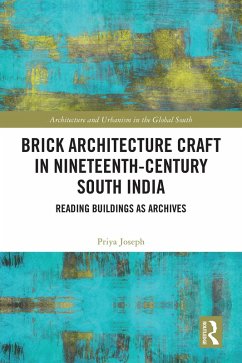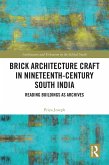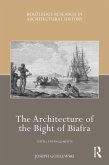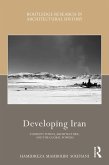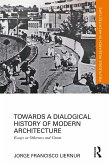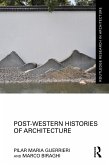Priya Joseph
Brick Architecture Craft in Nineteenth-Century South India (eBook, ePUB)
Reading Buildings as Archives
42,95 €
42,95 €
inkl. MwSt.
Erscheint vor. 18.03.25

21 °P sammeln
42,95 €
Als Download kaufen

42,95 €
inkl. MwSt.
Erscheint vor. 18.03.25

21 °P sammeln
Jetzt verschenken
Alle Infos zum eBook verschenken
42,95 €
inkl. MwSt.
Erscheint vor. 18.03.25
Alle Infos zum eBook verschenken

21 °P sammeln
Unser Service für Vorbesteller - Ihr Vorteil ohne Risiko:
Sollten wir den Preis dieses Artikels vor dem Erscheinungsdatum senken, werden wir Ihnen den Artikel bei der Auslieferung automatisch zum günstigeren Preis berechnen.
Sollten wir den Preis dieses Artikels vor dem Erscheinungsdatum senken, werden wir Ihnen den Artikel bei der Auslieferung automatisch zum günstigeren Preis berechnen.
Priya Joseph
Brick Architecture Craft in Nineteenth-Century South India (eBook, ePUB)
Reading Buildings as Archives
- Format: ePub
- Merkliste
- Auf die Merkliste
- Bewerten Bewerten
- Teilen
- Produkt teilen
- Produkterinnerung
- Produkterinnerung

Bitte loggen Sie sich zunächst in Ihr Kundenkonto ein oder registrieren Sie sich bei
bücher.de, um das eBook-Abo tolino select nutzen zu können.
Hier können Sie sich einloggen
Hier können Sie sich einloggen
Sie sind bereits eingeloggt. Klicken Sie auf 2. tolino select Abo, um fortzufahren.

Bitte loggen Sie sich zunächst in Ihr Kundenkonto ein oder registrieren Sie sich bei bücher.de, um das eBook-Abo tolino select nutzen zu können.
This book explores brick architecture of the nineteenth century in South India, through the lens of tectonics and materiality.
- Geräte: eReader
- mit Kopierschutz
- eBook Hilfe
- Größe: 15.33MB
Andere Kunden interessierten sich auch für
![Brick Architecture Craft in Nineteenth-Century South India (eBook, PDF) Brick Architecture Craft in Nineteenth-Century South India (eBook, PDF)]() Priya JosephBrick Architecture Craft in Nineteenth-Century South India (eBook, PDF)42,95 €
Priya JosephBrick Architecture Craft in Nineteenth-Century South India (eBook, PDF)42,95 €![Architecture and Urbanism in a Contact Zone (eBook, ePUB) Architecture and Urbanism in a Contact Zone (eBook, ePUB)]() Mark Mukherjee CampbellArchitecture and Urbanism in a Contact Zone (eBook, ePUB)42,95 €
Mark Mukherjee CampbellArchitecture and Urbanism in a Contact Zone (eBook, ePUB)42,95 €![The Architecture of the Bight of Biafra (eBook, ePUB) The Architecture of the Bight of Biafra (eBook, ePUB)]() Joseph GodlewskiThe Architecture of the Bight of Biafra (eBook, ePUB)42,95 €
Joseph GodlewskiThe Architecture of the Bight of Biafra (eBook, ePUB)42,95 €![Developing Iran (eBook, ePUB) Developing Iran (eBook, ePUB)]() Hamidreza Mahboubi SoufianiDeveloping Iran (eBook, ePUB)42,95 €
Hamidreza Mahboubi SoufianiDeveloping Iran (eBook, ePUB)42,95 €![Towards a Dialogical History of Modern Architecture (eBook, ePUB) Towards a Dialogical History of Modern Architecture (eBook, ePUB)]() Jorge Francisco LiernurTowards a Dialogical History of Modern Architecture (eBook, ePUB)42,95 €
Jorge Francisco LiernurTowards a Dialogical History of Modern Architecture (eBook, ePUB)42,95 €![New Narratives of Russian and East European Art (eBook, ePUB) New Narratives of Russian and East European Art (eBook, ePUB)]() New Narratives of Russian and East European Art (eBook, ePUB)34,95 €
New Narratives of Russian and East European Art (eBook, ePUB)34,95 €![Post-Western Histories of Architecture (eBook, ePUB) Post-Western Histories of Architecture (eBook, ePUB)]() Pilar Maria GuerrieriPost-Western Histories of Architecture (eBook, ePUB)42,95 €
Pilar Maria GuerrieriPost-Western Histories of Architecture (eBook, ePUB)42,95 €-
-
-
This book explores brick architecture of the nineteenth century in South India, through the lens of tectonics and materiality.
Dieser Download kann aus rechtlichen Gründen nur mit Rechnungsadresse in A, B, BG, CY, CZ, D, DK, EW, E, FIN, F, GR, HR, H, IRL, I, LT, L, LR, M, NL, PL, P, R, S, SLO, SK ausgeliefert werden.
Produktdetails
- Produktdetails
- Verlag: Taylor & Francis eBooks
- Erscheinungstermin: 18. März 2025
- Englisch
- ISBN-13: 9781040331149
- Artikelnr.: 73154423
- Verlag: Taylor & Francis eBooks
- Erscheinungstermin: 18. März 2025
- Englisch
- ISBN-13: 9781040331149
- Artikelnr.: 73154423
- Herstellerkennzeichnung Die Herstellerinformationen sind derzeit nicht verfügbar.
Priya Joseph teaches at Srishti Manipal Institute of Art, Design and Technology, MAHE, Bengaluru, India, and is an architect by training. Her work transects architectural history, urban ecologies, art and design in the urban, and material culture. She has published widely on architecture, and materiality, including Terracotta People (2024) and Rupturing Terracotta: Entangled Exchanges of the Hand and the Machine in South India (2022).
List of figures List of abbreviations Acknowledgements Glossary Part 1: Reading the Archive Chapter 1: The Humble Brick: Material for a Billion
Brick: Construction Material for a Billion
The Decolonial Lens
Hybridity
Standardisation, Mechanisation, Automation
Brick: Contemporary Challenges
Structure and Themes of the Book Chapter 2: Precolonial to Colonial: History of Brick in the Indian Subcontinent
Bricks: Indus to the Nineteenth-century Colonial India
Regional Variations
Missionaries and Factories
Terracotta/Fired Earth: Colonisers Trailing the Missionaries
Terracotta Brick and Tile Industry in Mangalore
The Basel Mission Printing Press
Other Terracotta Tiles Chapter 3: Nineteenth-Century Conversations between the Indigenous and the Colonial
Introduction
Methods and Manuals
The Anthropology of Bricks: Brick-makers of Burma
Coloured Bricks
Well Sinkers: Manual to Mechanised
Brick, Mortar and Plasters of the Nineteenth-century India
Colonial Coercion
The Old and the New Archives Part 2: Drawing the Archives Chapter 4: Why Read and Draw Buildings as Archives?
Traditional Taxonomy in Architectural History
What is an Archive?
Technique and Material as an Anchor of Architectural Analysis
Brick in Focus
The Hidden Historical Archives in the Tectonic Making of Architecture
Tracing the Intersections
A Case Study Method
Manual Measured Drawings Versus Advanced Digital Techniques
Handmade versus Machine-made
The Decolonial Shift Chapter 5: Hybridity: Materiality and Tectonic of the Chatrams of Thanjavur
Introduction
Cases in Brick
Chatrams of Thanjavur - Why are the Chatrams of Thanjavur Important?
Sculptural and Assembled Derivation in Architecture
Muktambal (1801) and Yamunambal Chatrams, Thanjavur (1761) - Typology - Details in Brick
Vennar (1779), Kalyana Mahal (1832) and Shreyas Chatrams (1837) - Details in Brick - Column, Openings and Walls in Brick
Hybridity Chapter 6: Brick Tectonics of a Church, a School and a Market
Rosary Church of Shettihalli, 1810-1880 - Brick Ruins and the Story of Technology - Typology and Drawings - Elements of Architecture
Tracing Hybridity Through Drawing
The Red Kirk at Bengaluru, 1864
Fort School, Bengaluru, 1907 - Typology and Drawings - Elements of Architecture - Material Technique and Columns
New Material and Traditional Skills
Devaraja Market, Mysore, Karnataka, 1900 - Typology and Drawings - Elements of Architecture
Roofs with Steel Chapter 7: Future: Contemporary Architecture with Bricks and Adobe
Standardisation: A Consequence of Nineteenth-century Mass Production
Twentieth-century Experiments in Brick
Contemporary Brick Architecture in South Asia
Brick in the Forefront
Conclusion Index
Brick: Construction Material for a Billion
The Decolonial Lens
Hybridity
Standardisation, Mechanisation, Automation
Brick: Contemporary Challenges
Structure and Themes of the Book Chapter 2: Precolonial to Colonial: History of Brick in the Indian Subcontinent
Bricks: Indus to the Nineteenth-century Colonial India
Regional Variations
Missionaries and Factories
Terracotta/Fired Earth: Colonisers Trailing the Missionaries
Terracotta Brick and Tile Industry in Mangalore
The Basel Mission Printing Press
Other Terracotta Tiles Chapter 3: Nineteenth-Century Conversations between the Indigenous and the Colonial
Introduction
Methods and Manuals
The Anthropology of Bricks: Brick-makers of Burma
Coloured Bricks
Well Sinkers: Manual to Mechanised
Brick, Mortar and Plasters of the Nineteenth-century India
Colonial Coercion
The Old and the New Archives Part 2: Drawing the Archives Chapter 4: Why Read and Draw Buildings as Archives?
Traditional Taxonomy in Architectural History
What is an Archive?
Technique and Material as an Anchor of Architectural Analysis
Brick in Focus
The Hidden Historical Archives in the Tectonic Making of Architecture
Tracing the Intersections
A Case Study Method
Manual Measured Drawings Versus Advanced Digital Techniques
Handmade versus Machine-made
The Decolonial Shift Chapter 5: Hybridity: Materiality and Tectonic of the Chatrams of Thanjavur
Introduction
Cases in Brick
Chatrams of Thanjavur - Why are the Chatrams of Thanjavur Important?
Sculptural and Assembled Derivation in Architecture
Muktambal (1801) and Yamunambal Chatrams, Thanjavur (1761) - Typology - Details in Brick
Vennar (1779), Kalyana Mahal (1832) and Shreyas Chatrams (1837) - Details in Brick - Column, Openings and Walls in Brick
Hybridity Chapter 6: Brick Tectonics of a Church, a School and a Market
Rosary Church of Shettihalli, 1810-1880 - Brick Ruins and the Story of Technology - Typology and Drawings - Elements of Architecture
Tracing Hybridity Through Drawing
The Red Kirk at Bengaluru, 1864
Fort School, Bengaluru, 1907 - Typology and Drawings - Elements of Architecture - Material Technique and Columns
New Material and Traditional Skills
Devaraja Market, Mysore, Karnataka, 1900 - Typology and Drawings - Elements of Architecture
Roofs with Steel Chapter 7: Future: Contemporary Architecture with Bricks and Adobe
Standardisation: A Consequence of Nineteenth-century Mass Production
Twentieth-century Experiments in Brick
Contemporary Brick Architecture in South Asia
Brick in the Forefront
Conclusion Index
List of figures List of abbreviations Acknowledgements Glossary Part 1: Reading the Archive Chapter 1: The Humble Brick: Material for a Billion
Brick: Construction Material for a Billion
The Decolonial Lens
Hybridity
Standardisation, Mechanisation, Automation
Brick: Contemporary Challenges
Structure and Themes of the Book Chapter 2: Precolonial to Colonial: History of Brick in the Indian Subcontinent
Bricks: Indus to the Nineteenth-century Colonial India
Regional Variations
Missionaries and Factories
Terracotta/Fired Earth: Colonisers Trailing the Missionaries
Terracotta Brick and Tile Industry in Mangalore
The Basel Mission Printing Press
Other Terracotta Tiles Chapter 3: Nineteenth-Century Conversations between the Indigenous and the Colonial
Introduction
Methods and Manuals
The Anthropology of Bricks: Brick-makers of Burma
Coloured Bricks
Well Sinkers: Manual to Mechanised
Brick, Mortar and Plasters of the Nineteenth-century India
Colonial Coercion
The Old and the New Archives Part 2: Drawing the Archives Chapter 4: Why Read and Draw Buildings as Archives?
Traditional Taxonomy in Architectural History
What is an Archive?
Technique and Material as an Anchor of Architectural Analysis
Brick in Focus
The Hidden Historical Archives in the Tectonic Making of Architecture
Tracing the Intersections
A Case Study Method
Manual Measured Drawings Versus Advanced Digital Techniques
Handmade versus Machine-made
The Decolonial Shift Chapter 5: Hybridity: Materiality and Tectonic of the Chatrams of Thanjavur
Introduction
Cases in Brick
Chatrams of Thanjavur - Why are the Chatrams of Thanjavur Important?
Sculptural and Assembled Derivation in Architecture
Muktambal (1801) and Yamunambal Chatrams, Thanjavur (1761) - Typology - Details in Brick
Vennar (1779), Kalyana Mahal (1832) and Shreyas Chatrams (1837) - Details in Brick - Column, Openings and Walls in Brick
Hybridity Chapter 6: Brick Tectonics of a Church, a School and a Market
Rosary Church of Shettihalli, 1810-1880 - Brick Ruins and the Story of Technology - Typology and Drawings - Elements of Architecture
Tracing Hybridity Through Drawing
The Red Kirk at Bengaluru, 1864
Fort School, Bengaluru, 1907 - Typology and Drawings - Elements of Architecture - Material Technique and Columns
New Material and Traditional Skills
Devaraja Market, Mysore, Karnataka, 1900 - Typology and Drawings - Elements of Architecture
Roofs with Steel Chapter 7: Future: Contemporary Architecture with Bricks and Adobe
Standardisation: A Consequence of Nineteenth-century Mass Production
Twentieth-century Experiments in Brick
Contemporary Brick Architecture in South Asia
Brick in the Forefront
Conclusion Index
Brick: Construction Material for a Billion
The Decolonial Lens
Hybridity
Standardisation, Mechanisation, Automation
Brick: Contemporary Challenges
Structure and Themes of the Book Chapter 2: Precolonial to Colonial: History of Brick in the Indian Subcontinent
Bricks: Indus to the Nineteenth-century Colonial India
Regional Variations
Missionaries and Factories
Terracotta/Fired Earth: Colonisers Trailing the Missionaries
Terracotta Brick and Tile Industry in Mangalore
The Basel Mission Printing Press
Other Terracotta Tiles Chapter 3: Nineteenth-Century Conversations between the Indigenous and the Colonial
Introduction
Methods and Manuals
The Anthropology of Bricks: Brick-makers of Burma
Coloured Bricks
Well Sinkers: Manual to Mechanised
Brick, Mortar and Plasters of the Nineteenth-century India
Colonial Coercion
The Old and the New Archives Part 2: Drawing the Archives Chapter 4: Why Read and Draw Buildings as Archives?
Traditional Taxonomy in Architectural History
What is an Archive?
Technique and Material as an Anchor of Architectural Analysis
Brick in Focus
The Hidden Historical Archives in the Tectonic Making of Architecture
Tracing the Intersections
A Case Study Method
Manual Measured Drawings Versus Advanced Digital Techniques
Handmade versus Machine-made
The Decolonial Shift Chapter 5: Hybridity: Materiality and Tectonic of the Chatrams of Thanjavur
Introduction
Cases in Brick
Chatrams of Thanjavur - Why are the Chatrams of Thanjavur Important?
Sculptural and Assembled Derivation in Architecture
Muktambal (1801) and Yamunambal Chatrams, Thanjavur (1761) - Typology - Details in Brick
Vennar (1779), Kalyana Mahal (1832) and Shreyas Chatrams (1837) - Details in Brick - Column, Openings and Walls in Brick
Hybridity Chapter 6: Brick Tectonics of a Church, a School and a Market
Rosary Church of Shettihalli, 1810-1880 - Brick Ruins and the Story of Technology - Typology and Drawings - Elements of Architecture
Tracing Hybridity Through Drawing
The Red Kirk at Bengaluru, 1864
Fort School, Bengaluru, 1907 - Typology and Drawings - Elements of Architecture - Material Technique and Columns
New Material and Traditional Skills
Devaraja Market, Mysore, Karnataka, 1900 - Typology and Drawings - Elements of Architecture
Roofs with Steel Chapter 7: Future: Contemporary Architecture with Bricks and Adobe
Standardisation: A Consequence of Nineteenth-century Mass Production
Twentieth-century Experiments in Brick
Contemporary Brick Architecture in South Asia
Brick in the Forefront
Conclusion Index
